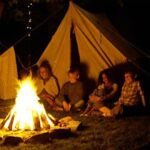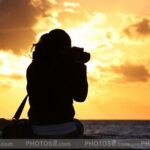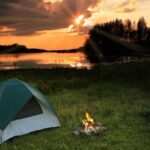by Liz Childers
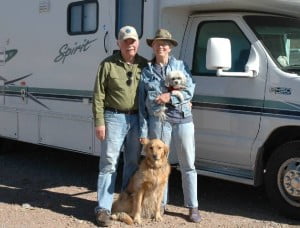
Lost in the Woods recently caught up with Fred and Suzi Dow while they were at a campground in South Dakota. For 17 years, the Dows have been visiting the national forests and grasslands in order to provide others with the information they need about campgrounds at these sites. Last week, we shared an article on Fred and Suzi’s thoughts on camping in the forests and grasslands. Here is our Q&A with the Dows, so you can get to know more about their immensely interesting project that has helped all campers’ experiences in these national treasures.
1.) Was there a particular experience that made you start this project? About September 1994, Fred and I discovered national forest camping when attempting to find lodging for a Folk Festival in southern Virginia. All the area’s hotels, motels, B&Bs, and private campgrounds were full. One of Fred’s co-workers suggested Beartree Campground in something called Jefferson National Forest. We did some research to determine if there was potable water, bathrooms, showers, hiking trails, direction on how to get there, etc. We could not find published material either on the web (very limited at the time) or in the library. So, in terms of what was lacking – everything. On the drive back home from Beartree campground, we decide to fill the information void by developing a website that would provide the public with comprehensive national forest campground information. After meeting with the Forest Service in Washington, DC a few months later and receiving its blessing to develop a website providing developed campground information in national forests (and later grasslands), we proceeded to finalize our data collection vehicle.
2.) When you began this project, what was the information you hoped to provide to the public about campgrounds?
We started our project with 50 data points on our collection sheet. Thanks to input from our readers over the years, we now collect up to 57 points, or fields of data, and have expanded our narrative comments. See the South Clear Lake campground description in the Wenatchee National Forest as an example for data fields. We are gradually adding “Equestrian Camping” and “GPS coordinates” as new fields. The latter field and campground location maps are provided only in our eleven Ebooks on CD and Ebook downloads. Our goal is to increase the public’s awareness and knowledge of national forests/grasslands and the developed camping opportunities found there by building a consolidated source of information. We do not rate the campgrounds. Rather, we try to provide enough information for the camper to decide whether a particular campground is the experience desired.
3.) When you’re visiting a campground, what do you look for to report back to your readers and to cover for your campgrounds guide?
Basically, we try to provide the information needed to make an informed decision about where to camp and whether a national forest/grassland is the experience the camper wants. The camper’s selection of a campground may also be helped by over 6000 photographs provided on our website.
4.) What kind of feedback have you gotten as a result of this project?
Between our website, blog, forum, monthly newsletter, emails, and social media venues, feedback has been positive and very gratifying. Our readers are critical to maintaining the quality of information presented. They have been super about letting us know when data is out-of date. It took us 17 years to do what we have done so far. No telling when we might get back to all those locations. So, inputs from our readers and the responses from the Forest Service to our annual faxes requesting updates to their campground’s fee, season, and reservation status are critical.
5.) What’s the most rewarding experience about this project?
Having people discover national forests and grasslands. Each time we receive an email from someone who has enjoyed their first or hundredth national forest or grassland experience, we are delighted.
The Dows’ photo of Sahalie Falls in Oregon’s Coldwater Cove and Ice Cap Creek Campgrounds
6.) What was it like to achieve your goal of visiting every National Forest with developed campgrounds?
Euphoria that we can provide such a wealth of information to help campers experience their heritage, natural beauty, and history. We have visited and surveyed around 2400 national forest and grassland campgrounds but there are so many more forests and grassland experiences left to be enjoyed in these treasured lands. And we plan to do so. It is good to know others can feel comfortable having their own experiences and adventures in a place they may never have enjoyed if not for our efforts. We end every presentation by telling our audience “Get out there and enjoy your national forest or grasslands” and we mean it completely.
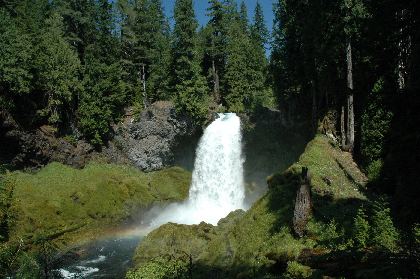
Finally, it’s nice to feel that we may be the only people to visit all the national forests and grasslands (except Puerto Rico).
7.) Has the completion of this goal in 2008 changed your research focus, since you’ve been to every National Forest?
Since 2008 we have continued our project by researching national grasslands and re-researching national forests we did earlier, bringing them up to the same level as our later work. The change to our research focus is to provide the same level of information for all the campgrounds posted on the website and in our eleven Ebooks. This includes providing more and higher quality photographs.
8.) What do you foresee as the future of this project?
We plan to continue re-visiting national forests and grasslands, updating and improving our website and guides and spreading the word that national forests and grasslands are a fabulous recreation resource.

